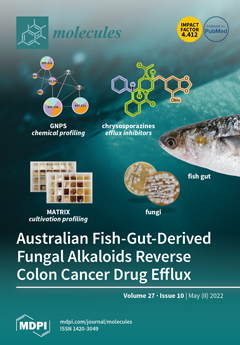Three new polycyclic phenol derivatives, 2-acetyl-4-hydroxy-6H-furo [2,3-g]chromen-6-one (
1), 2-(1′,2′-dihydroxypropan-2′-yl)-4-hydroxy-6H-furo [2,3-g][1]benzopyran-6-one (
2) and 3,8,10-trihydroxy-4,9-dimethoxy-6H-benzo[c]chromen-6-one (
8), along with seven known ones (
3–
7,
9 and
10) were isolated for the first time from the leaves
[...] Read more.
Three new polycyclic phenol derivatives, 2-acetyl-4-hydroxy-6H-furo [2,3-g]chromen-6-one (
1), 2-(1′,2′-dihydroxypropan-2′-yl)-4-hydroxy-6H-furo [2,3-g][1]benzopyran-6-one (
2) and 3,8,10-trihydroxy-4,9-dimethoxy-6H-benzo[c]chromen-6-one (
8), along with seven known ones (
3–
7,
9 and
10) were isolated for the first time from the leaves of
Spermacoce latifolia. Their structures were determined by spectroscopic analysis and comparison with literature-reported data. These compounds were tested for their in vitro antibacterial activity against four Gram-(+) bacteria:
Staphyloccocus aureus (
SA), methicillin-resistant
Staphylococcus aureus (
MRSA),
Bacillus cereus (
BC),
Bacillus subtilis (
BS), and the Gram-(−) bacterium
Escherichia coli. Compounds
1,
2,
5 and
8 showed antibacterial activity toward
SA,
BC and
BS with MIC values ranging from 7.8 to 62.5 µg/mL, but they were inactive to
MRSA. Compound
4 not only showed the best antibacterial activity against
SA,
BC and
BS, but it further displayed significant antibacterial activity against
MRSA (MIC 1.95 µg/mL) even stronger than vancomycin (MIC 3.9 µg/mL). No compounds showed inhibitory activity toward
E. coli. Further bioassay indicated that compounds
1,
4,
5,
6,
8 and
9 showed in vitro
α-glucosidase inhibitory activity, among which compound
9 displayed the best
α-glucosidase inhibitory activity with IC
50 value (0.026 mM) about 15-fold stronger than the reference compound acarbose (IC
50 0.408 mM). These results suggested that compounds
4,
8 and
9 were potentially highly valuable compounds worthy of consideration to be further developed as an effective anti-
MRSA agent or effective
α-glucosidase inhibitors, respectively. In addition, the obtained data also supported that
S. latifolia was rich in structurally diverse bioactive compounds worthy of further investigation, at least in searching for potential antibiotics and
α-glucosidase inhibitors.
Full article






